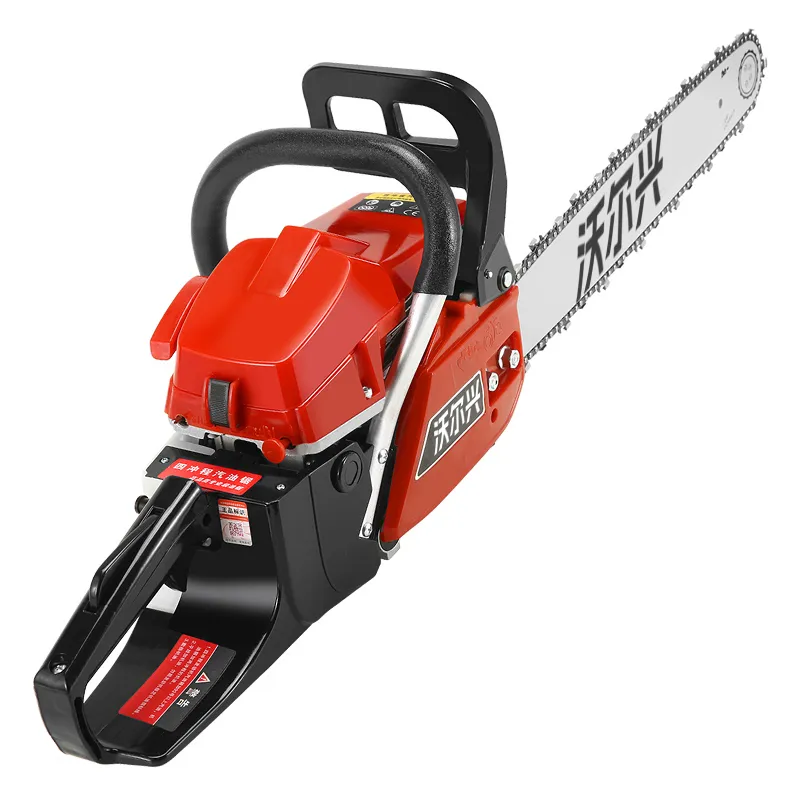A Beginner’s Guide to Using a Chain Saw Safely and Effectively
2024-09-10
A chainsaw is a powerful tool used for a variety of tasks, from cutting firewood to felling trees and pruning branches. Whether you're a homeowner with occasional yard work or a professional in forestry, understanding how to use a chainsaw safely is crucial. In this blog, we will cover the basics of chainsaw operation, safety tips, and the key features to look for when purchasing a chainsaw.
1. Understanding the Components of a Chain Saw
Before diving into operation and safety, it's important to familiarize yourself with the basic components of a chainsaw:
- Engine/Motor: The power source that drives the chain. It can be gas-powered or electric (battery or corded).
- Guide Bar: The long metal bar around which the chain rotates. The length of the guide bar determines the size of the trees or branches that can be cut.
- Chain: The cutting tool made of sharp metal teeth that rotates around the guide bar.
- Throttle: Controls the engine’s speed and chain rotation.
- Chain Brake: A safety feature that stops the chain from moving if there's a kickback.
- Handle: Provides the operator with control over the tool.
2. Choosing the Right Chain Saw
Before purchasing a chainsaw, it's important to choose the right one for your needs. The main types of chainsaws are:
- Gas-Powered Chainsaws: These are the most powerful and are typically used for heavy-duty tasks such as felling large trees. They offer great mobility but require more maintenance, such as refueling and oil changes.
- Electric Chainsaws: Corded electric chainsaws are great for lighter tasks like trimming branches or cutting small trees. They require a power source and are quieter than gas models, but the cord limits mobility.
- Battery-Powered Chainsaws: These are more portable than corded electric models and suitable for medium-duty work. They provide decent power and mobility but are limited by battery life.
- Bar Length: If you're cutting large trees, choose a chainsaw with a longer guide bar (16 inches or more). For smaller tasks, a 12- to 14-inch bar should suffice.

3. Safety Tips for Chainsaw Operation
Chainsaws are incredibly powerful tools, but they can be dangerous if not used properly. Here are some essential safety tips to follow:
a. Wear Protective Gear
Always wear appropriate safety gear when operating a chainsaw, including:
- Helmet with face shield: Protects your head and face from falling debris and wood chips.
- Hearing protection: Chainsaws are loud, and prolonged exposure can damage your hearing.
- Gloves: Protect your hands from cuts and vibrations.
- Chainsaw chaps or pants: Special clothing designed to stop the chainsaw if it comes into contact with your leg.
- Steel-toe boots: Provide protection in case the chainsaw drops.
b. Check the Chain and Bar
Ensure the chain is sharp and properly tensioned. A dull or loose chain can cause kickback or slip, increasing the risk of injury. Make sure the chain brake is functional and that the guide bar is straight and free of damage.
c. Start Properly
When starting a chainsaw, place it on a flat, stable surface. Hold the saw firmly and pull the starter cord in a controlled motion. Never start the chainsaw while holding it in the air.
d. Avoid Kickback
Kickback happens when the tip of the guide bar hits an object or the chain is pinched, causing the saw to jerk back toward the operator. To avoid this, always cut with the middle portion of the bar and never the tip. Use the chain brake when moving between cuts.
e. Clear the Area
Before starting, ensure that your work area is clear of obstacles like rocks or loose branches. Make sure no one is standing close to the area where you’re working, as they could be injured by flying debris.
4. Basic Chainsaw Maintenance
Proper maintenance will extend the life of your chainsaw and ensure it operates safely.
- Keep the Chain Sharp: A sharp chain reduces the amount of effort required to cut and lowers the risk of kickback. Use a chainsaw file or sharpening kit to maintain sharpness.
- Check Oil Levels: Always keep the bar and chain lubricated with oil to prevent overheating. Refill the oil reservoir regularly, especially during long periods of use.
- Clean the Air Filter: For gas-powered chainsaws, keep the air filter clean to maintain engine performance. A clogged filter can reduce power and increase fuel consumption.
- Inspect the Spark Plug: If you notice difficulty starting your gas chainsaw, check and clean the spark plug. Replace it if necessary.
5. Using a Chainsaw for Different Tasks
Cutting Firewood: Use a bucking technique where you cut the wood into sections. Ensure the log is stable and supported before cutting, and always cut on the opposite side from where you’re standing.
Felling Trees: Felling requires more skill and caution. Start by planning an escape route, then make a notch cut on the side where you want the tree to fall. Follow up with a felling cut on the opposite side, stopping before the tree starts to lean.
Pruning and Limbing: For trimming branches or limbs, keep the saw at waist level and avoid cutting overhead. Make smaller cuts to prevent limbs from snapping back toward you.
Conclusion
A chainsaw is a versatile and powerful tool, but it requires knowledge and care to use safely. By choosing the right chainsaw for your needs, following safety guidelines, and maintaining your equipment, you can tackle a wide range of cutting tasks with confidence. Always remember that safety should come first, and proper training is essential for operating this tool.


